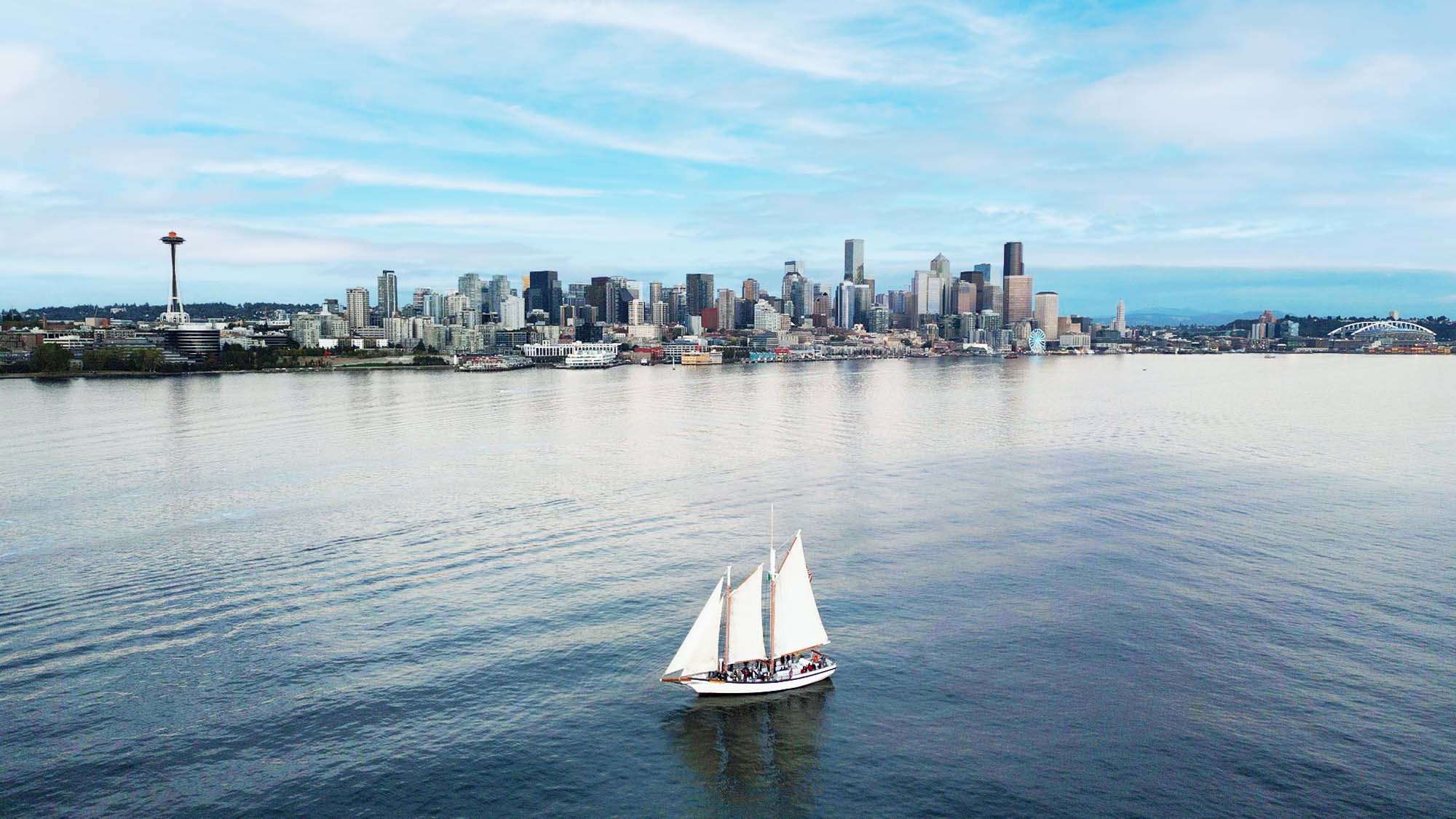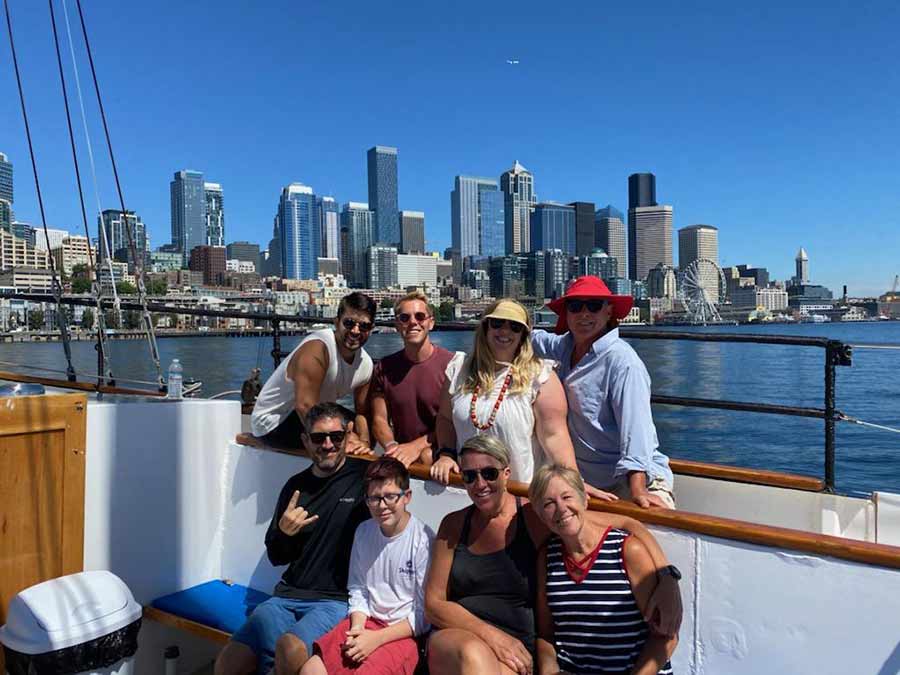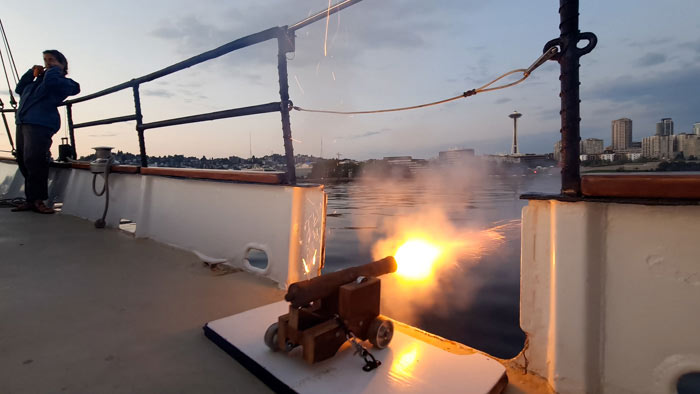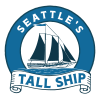
Elliott Bay Pier Pirates and Seattle’s Seedy Waterfront History
Seattle’s waterfront holds more than scenic views and sailboats. It has always been a place where stories gather like driftwood—some proud, some shady, some nearly forgotten. In the late 1800s and early 1900s, Elliott Bay wasn’t just the city’s front door. It was a hub of restless activity, a tide-fed maze of piers, cargo, and opportunity. With so much coming and going, it didn’t take long for mischief to take root. Hidden behind the bustle of commerce was an undercurrent of theft, smuggling, and seafaring trickery. These are the stories of the Elliott Bay pier pirates—dockside criminals who made the most of chaos and shadow.
Today, the Bay Lady sails across the same waters where these tales first stirred. Step aboard, and you’re not just catching the breeze; you’re drifting across living history.

The Working Waterfront in Seattle’s Boom Years
In the decades following the Great Seattle Fire of 1889, the city grew rapidly—and nowhere was that growth more visible than on the waterfront. Piers stretched farther into the bay each year. Logging ships unloaded cargo while fishing vessels came in with their daily catch. Steamers arrived from Alaska loaded with gold rush passengers, and colliers carried coal out to the world. Every corner of the bay was busy.
The infrastructure struggled to keep up. Longshoremen were overworked and underpaid. Regulations were patchy at best. And beneath the clamor of honest work, Elliott Bay became fertile ground for quiet theft and backdoor deals. On crowded docks, it was easy for a crate to go missing or for someone to slip into the cargo hold of a ship after dark.
Many of the original piers no longer exist, but the maps from the time show how the city spilled into the water in a tangle of dock lines and gangways. Every vessel and warehouse added layers to Seattle’s maritime culture—and gave new places for shady characters to hide.
Dockside Crime and Seattle’s “Pier Rats”
With so much cargo changing hands, theft became part of the daily rhythm. Some of it was opportunistic. A barrel left unattended. A shipment logged incorrectly. But over time, dockside crime took on more organization. Certain gangs built systems for siphoning goods from arriving ships. Inside contacts would mark the right containers or tip off the timing of a delivery.
Local newspapers from the early 1900s mention “pier rats”—young boys and idle men who lingered near the wharves, always watching. They weren’t always thieves themselves, but many were runners, errand boys, or low-level scouts who knew what cargo came in and which crews could be bribed.
One popular tactic was “short loading.” Dockworkers would quietly skim from the top of a shipment—perhaps a few bags of flour or some valuable tools—and adjust the paperwork just enough to avoid detection. Sometimes, the loot ended up in nearby alley markets. Other times, it was ferried away in rowboats under the cover of night.
Crime wasn’t constant, but it was part of the atmosphere. Ask the right old-timer in Pioneer Square, and you might still hear about the time a gang made off with an entire piano. No one knew how they got it down the gangplank without being seen.

Looking for an unforgettable day on the water? Seattle’s Tall Ship’s “Bay Lady” offers a unique opportunity to experience the magic of tall ship sailing in the heart of Seattle. Step aboard this magnificent vessel and sail into history as you take in the beauty of Elliott Bay and the Seattle skyline. Don’t miss your chance to embark on a one-of-a-kind adventure—book your sail today!




Guests enjoy the sights and sounds of a tall ship tour onboard Seattle’s Tall Ships, “The Bay Lady”.
Bootleggers, Bribes, and Elliott Bay’s Prohibition Era
The 1920s brought something new to Seattle’s piers: liquor. When Prohibition took hold, the city’s maritime geography suddenly offered a major advantage to those looking to skirt the law. Canada was close, Elliott Bay was deep, and the region’s foggy nights made smuggling feel almost easy.
Small boats began arriving under darkness, hauling crates of whisky and rum. Most didn’t dock. They hovered offshore or slipped into quieter corners of the harbor. Bribes kept some watchmen quiet. Others just looked the other way.
The Coast Guard cracked down hard. Newspapers carried stories of high-speed boat chases across the Sound. Still, the liquor kept coming. Some crews even hollowed out legitimate cargo shipments to conceal bottles. On at least one occasion, a customs raid turned up dozens of liquor cases hidden inside a shipment of cured salmon.
It wasn’t just sailors and smugglers. Some well-dressed businessmen were in on it too—financing the operation or laundering the profits through waterfront taverns. By the time Prohibition ended, Elliott Bay had become one of the West Coast’s most quietly efficient gateways for underground commerce.
The lines between lawful trade and quiet crime blurred. That legacy still hangs in the air, especially on a misty morning when the water is still and silent.


What’s Left of the Old Waterfront Today
Seattle’s shoreline has changed dramatically, but the past hasn’t vanished. Piers have been rebuilt. Warehouses turned into restaurants. Streets have shifted. But if you slow down and look close, echoes of the old harbor are still there.
In Pioneer Square, cobblestone streets meet the smell of salt air. The original shipping hub, Yesler Way, now cuts through a neighborhood filled with plaques, murals, and historic markers. The Smith Tower, once the tallest building on the West Coast, watched over all of it.
A few blocks away, the Seattle Underground Tour walks visitors through buried storefronts and forgotten tunnels—some of which likely helped certain shady shipments move unseen.
Waterfront Park now stretches along the shore where the original piers stood, but the view is familiar. Cargo cranes still march across the horizon. Ferries churn up the same waters where pirates and bootleggers once rowed silently past watchful eyes.
Sail the Bay Where History Still Echoes
The best way to feel this history isn’t by reading a plaque. It’s by being on the water. Standing on the deck of Seattle’s Tall Ships’ the “Bay Lady“, sails full, with downtown rising behind you and the Olympic Mountains in the distance—you’re floating through the very same harbor where these tales once played out.
Today’s waterfront is full of charm and comfort, but the waters still carry the rhythm of the past. The same tides that brought in gold rush steamers and Prohibition smugglers are still moving beneath the hull. The same skyline that once flickered with oil lamps now glows with city lights.
As you sail across Elliott Bay, you can spot the outlines of old pier locations. Your captain might share stories of tall ships that once anchored nearby. The creak of the rigging and the rush of wind feel timeless. If you close your eyes, it’s easy to imagine a wooden schooner slipping past under cover of night, cargo hold loaded with forbidden barrels.

History Lingers in the Salt Air
The stories of Elliott Bay pier pirates aren’t tucked away in museums. They drift in the air, etched into the pilings and echoed in the cries of seagulls. Seattle’s harbor has always been alive—with people, with tides, and with tales that refuse to sink.
If you want to feel that connection, step off the sidewalk and into the wind. Join a sail on the Bay Lady, glide past the same piers where the past played out, and let the breeze carry a few old secrets back to shore.
There’s history in this harbor. You just have to go find it.
Book a sail with Seattle’s Tall Ship
If you have never experienced the thrill of sailing on our tall ship, there is no better time to try than now. With multiple sailing times and experiences available, our family-friendly harbor experiences are a must-do Seattle activity. Join us today!
